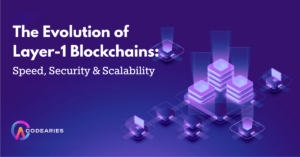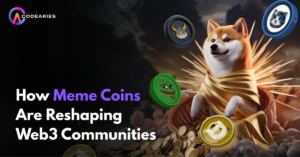The blockchain industry is evolving quickly, and 2025 promises to be a key year for both widespread use and new ideas. Blockchain technology is moving beyond cryptocurrencies; it is now influencing fields like finance, healthcare, logistics, entertainment, and more. As governments clarify regulations and companies invest more, blockchain is becoming an essential technology of the digital era.
In this blog, we’ll look at the main blockchain trends to monitor in 2025, covering enterprise applications, Web3 growth, AI integration, and eco-friendly blockchain solutions.
1. Mainstream Enterprise Blockchain Adoption
A major trend in 2025 is the growing use of blockchain by businesses. Companies like IBM, Oracle, and Microsoft have been offering blockchain solutions for years. Now, more everyday businesses are getting involved, using blockchain for:
- Supply chain transparency
- Cross-border payments
- Smart contract automation
- Asset tokenization
Industries such as automotive, pharmaceuticals, agriculture, and fashion are using blockchain for traceability, reducing fraud, and building customer trust.
Real-life example: Walmart is using blockchain to trace the origin of its food products. This ensures safety and reduces waste. Customers and regulators can scan a product to instantly access its journey from farm to shelf.
2. Rise of Central Bank Digital Currencies (CBDCs)
Governments globally are speeding up efforts to launch Central Bank Digital Currencies (CBDCs). In 2025, expect large economies like India, the EU, the UK, and possibly the US to start rolling out or testing their digital currencies.
CBDCs aim to update payment systems and lessen reliance on private cryptocurrencies. They promise:
- Faster settlements
- Greater financial inclusion
- Lower transaction costs
- More effective monetary tools
India’s Digital Rupee and China’s Digital Yuan are leading examples being monitored worldwide.
3. Web3 Growth and Decentralized Internet
Web3 has moved from a buzzword to a meaningful plan. In 2025, we will see more decentralized applications (dApps) and platforms that empower users by giving them control of their data, identity, and assets.
Key Web3 advancements to expect:
- Decentralized social media
- Blockchain-based identity solutions
- Creator-owned digital platforms
- Interoperable decentralized ecosystems
Projects like Polkadot, Cosmos, and Chainlink are advancing interoperability, allowing various blockchains to work together seamlessly.
Why it matters: With rising concerns over data privacy, Web3 offers a vision of a fairer, user-owned internet. This has significant impacts on advertising, e-commerce, and social media.

4. Tokenization of Real-World Assets (RWAs)
In 2025, anticipate significant growth in tokenized real-world assets, including:
- Real estate
- Fine art
- Commodities
- Private equity
- Carbon credits
Tokenization provides liquidity to assets that usually lack it and lowers the entry barrier for investors. Example: Platforms like RealT and tZero already provide tokenized real estate, allowing users to own fractional shares in rental properties and earn income from rent and potential appreciation.
5. Sustainable and Green Blockchain Solutions
With increasing concerns over climate change, eco-friendly blockchain technologies are gaining attention. Proof-of-Work blockchains like Bitcoin face criticism for their energy use. Alternatives like Proof-of-Stake (PoS) and Layer 2 scaling are becoming more popular.
Trends to expect:
- Blockchains focused on low energy use (e.g., Algorand, Tezos)
- Carbon-neutral or negative blockchain protocols
- Integration of carbon offset tracking on-chain
- Eco-based incentive systems like ReFi (Regenerative Finance)
Quick Fact: Ethereum’s switch to PoS in 2022 cut its energy consumption by over 99.9%. In 2025, many newer chains will adopt similar sustainable methods.
6. Integration of Blockchain and AI
The combination of Blockchain and Artificial Intelligence will spark innovation across many industries. AI can benefit from decentralized, transparent data, while blockchain networks can improve with AI-driven decision-making.
Key applications include:
- Decentralized AI marketplaces
- AI-powered smart contracts
- Secure and verifiable data sharing
- Real-time fraud detection
Projects like Ocean Protocol and Fetch.ai are leading these integrations, creating ecosystems where data owners can securely monetize their data while training AI models.
7. Blockchain in Gaming and the Metaverse
2025 will bring stronger growth for blockchain gaming and metaverse ecosystems. NFTs, in-game items, and token economies will become more complex and interconnected.
Expect:
- AAA blockchain games
- Interoperable in-game assets
- Play-to-earn (P2E) and Create-to-earn models
- Virtual real estate markets (e.g., Decentraland, The Sandbox)
Trend: Players will seek more transparency in item ownership and in-game economies. Blockchain provides solutions through digital property rights and provable scarcity.
8. Zero-Knowledge Proofs and Privacy Enhancements
As blockchain matures, privacy-focused technologies are gaining traction—especially Zero-Knowledge Proofs (ZKPs). These allow transactions to be validated without exposing any underlying details.
In 2025, watch for:
- Growth in zk-Rollups (scalable Layer 2 solutions)
- Privacy layers on public blockchains
- Secure voting and ID verification tools
- Wider use of confidential smart contracts
Use Case: zkSync and StarkNet are ZK-rollup technologies providing secure, low-cost transactions on Ethereum while maintaining privacy.
9. Blockchain-Powered Digital Identity
The move toward Self-Sovereign Identity (SSI) is gaining momentum. In 2025, blockchain-based digital identity will become practical for:
- KYC/AML compliance
- Healthcare records
- Education credentials
- Passport and visa systems
This can streamline processes, reduce identity theft, and give users complete control of their information.
Real-World Example: Estonia has set up a blockchain-based national ID system, enabling secure e-residency and digital services for citizens and users worldwide.
10. Greater Regulatory Clarity and Global Standards
Regulation uncertainty has been a major obstacle to blockchain use. However, in 2025, global organizations and national governments are expected to create clearer, more cohesive frameworks for:
- Crypto asset classification
- Taxation rules
- Stablecoin regulation
- Consumer protections
- AML/CFT compliance
Key development: The MiCA regulation in the European Union and evolving crypto tax policies in India, the UK, and the US will set global standards for how blockchain and crypto are legally treated.

Where CodeAries Comes In
As these trends grow, businesses will need dependable technology partners who can turn blockchain potential into real outcomes. This is where CodeAries excels.
CodeAries is a tech innovation company that specializes in blockchain development, AI/ML integration, metaverse solutions, mobile and web development, UI/UX design, and digital marketing. We create secure, scalable, and forward-thinking blockchain platforms tailored to your business model—whether you’re launching a token, building a dApp, integrating AI, or creating a digital identity platform. From consultation to deployment, our blockchain team ensures your product is user-friendly, ready for regulations, and prepared for future challenges.
Conclusion: 2025 – The Year Blockchain Becomes Unavoidable
Blockchain technology is moving into a phase of widespread use and change. What used to be a niche innovation is now becoming a core part of finance, governance, trade, and communication.
In 2025, the following key themes will shape the blockchain landscape:
- Institutional and government integration
- Improved privacy and scalability
- User-focused Web3 models
- Tokenization and the democratization of assets
- Sustainability and AI integration
Whether you’re an investor, a developer, a business owner, or just curious about what’s coming, it’s clear that blockchain is no longer just about crypto. It’s about changing how the world works—and with CodeAries, you’re empowered to lead that change.
FAQs – Blockchain in 2025 & CodeAries Solutions
Q1. Is blockchain really useful for industries beyond crypto?
Yes. Blockchain now powers systems in healthcare, logistics, education, entertainment, and finance by enabling transparency, security, and automation.
Q2. How does CodeAries help with blockchain development?
CodeAries offers complete services: ideation, design, smart contract development, testing, auditing, UI/UX, and post-launch support.
Q3. Can you help with green blockchain projects?
Absolutely. We build on eco-friendly platforms like Tezos, Solana, and Algorand and integrate carbon offset tracking and ReFi models into blockchain projects.
Q4. Do you work with startups and enterprises?
Yes, CodeAries partners with companies of all sizes—from emerging startups to global enterprises.
Q5. How can I get started with CodeAries?
Simply visit Codearies and fill out the contact form. Our team will connect with you for a free initial consultation.







